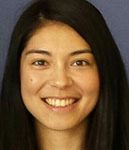
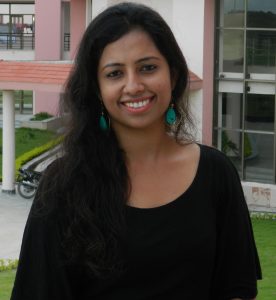 By Dr. Shawna Stanwood, Jefferies Lab & Sreeparna Vappala, PhD Student, Kizhakkedathu Lab
By Dr. Shawna Stanwood, Jefferies Lab & Sreeparna Vappala, PhD Student, Kizhakkedathu Lab
The Earl Davie Symposium is an annual Centre for Blood Research (CBR) event in honour of Dr. Earl Davie, a pioneer in deciphering blood coagulation at the molecular level. (For more information on Dr. Davie, see the Canadian Blood Services R.E.D. blog here). This year’s Symposium was held on November 13, 2019, at the University of British Columbia (UBC) Robson Square. With Dr. Davie and his son in attendance, Dr. Ed Conway, Director of the CBR, opened the meeting and announced Dr. David Lillicrap from Queen’s University as the recipient of the first Naiman-Vickars Visiting Professorship in benign hematology. This Professorship was established by the late hematologists Drs. Sheldon Naiman and Linda Vickars. This duo spearheaded several hematology programs in the Vancouver area, and played an important role in the growth of CBR, establishing an endowment fund that supports research, education, and training at the Centre.
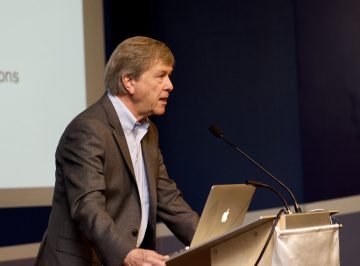
2019 Naiman-Vickars Visiting Professorship in Benign Hematology Dr. David Lillicrap (Queen’s University). All photo credits: Kitty Liu.
Following the announcement, Dr. Lillicrap delivered the first talk of the day on developments in hemophilia care, remarking that with the advent of long-circulating clotting factor substitutes, mimetic antibodies and gene therapy, the current decade is witnessing an unprecedented time of innovation in the clinical management of hemophilia. Dr. Joe Italiano (Harvard University) then gave some exciting insights into how his team is generating platelets in vitro from induced pluripotent stem cells using bio-inspired technologies.
The last talk before the coffee session was by Dr. Jorge Di Paola (Washington University in St. Louis), who spoke about genomic discovery approaches for inherited bleeding disorders. He commented that the reduced costs and advancements in genome sequencing have led to a quantum leap in the understanding of these disorders.
The coffee break was a hyper-efficient one filled with poster presentations and opportunities to network. CBR trainees often have the privilege to meet world-class experts and share their research with them. However, this year, through the Naiman-Vickars Endowment Fund, CBR was able to support 13 out-of-town trainees’ participation at this Symposium with travel awards. This also allowed the CBR researchers to learn more about the research accomplishments from other universities.
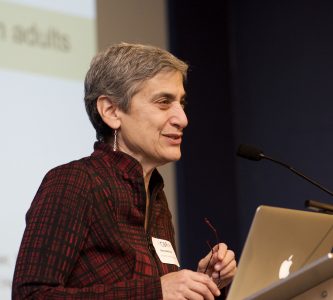
Keynote Speaker Dr. Nancy Berliner (Harvard University).
Shifting gears from the research talks, the post-coffee break session gave all a chance to listen to a patient’s perspective on hemophagocytic lymphohistiocytosis (HLH). Joseph Banagan was diagnosed with HLH, a rare medical condition that causes one’s immune system to be hyperactive. He captivated the audience with his positivity while sharing the story of his successful battle against this disease. His case and treatment strategies were then discussed by Dr. Deonne Guiran of UBC. Rounding up the morning invited speaker talks, keynote speaker Dr. Nancy Berliner (Harvard University) gave a comprehensive account of the diagnosis, prognosis and treatment of HLH in adults, highlighting the clinical differences between pediatric and adult HLH.
This led the way to the much-anticipated shotgun talks by poster presenters. Presenters came up with creative ways to summarize their research into a 30-second-long spiel. Many first-time Earl Davie Symposium presenters said that they enjoyed the shotgun talks, with Rida Malik from McMaster University commenting, “Shotgun talks pushed us to give the best message from our research.”
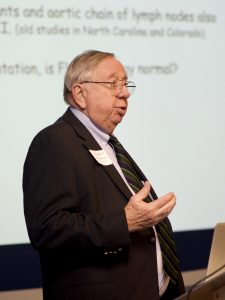
Keynote Speaker Dr. Robert Montgomery (Versiti Blood Center of Wisconsin).
After a delicious lunch, Dr. Robert Montgomery (Versiti Blood Center of Wisconsin), the final keynote speaker of the day, discussed the development of several rodent models of von Willebrand disease (VWD) in order to understand the biological relationship between von Willebrand factor (VWF) and FVIII. Subsequently, Dr. Nigel Mackman (University of North Carolina at Chapel Hill) covered the link between pancreatic cancer and the expression of tissue factor (TF) and touched upon the role of neutrophil extracellular traps and neutrophils in cancer-associated thrombosis. Dr. Mackman also joked that he was thankful to Dr. Davie for not cloning TF, which allowed him to “have a career.”
Dr. Katerina Akassoglou (Gladstone Institutes and University of California, San Francisco) described her group’s use of imaging tools to study the role of fibrinogen in neurological diseases. Next, Dr. Eric McGinnis (UBC) presented an intriguing case of a patient with highly discrepant FVIII test results, which led to a lively audience brainstorming discussion.
Wrapping up the outstanding event, Dr. Jonathan Lindner (Oregon Health & Science University) introduced a molecular imaging approach called contrast-enhanced ultrasound, which can be used to study atherosclerosis.
Throughout the day, trainees were able to showcase their research through oral presentations. Kimsey Platten (Bloodworks Northwest) discussed the role of lipoproteins in VWF self-association; Nabil Ali-Mohamad (UBC) described a self-propelled hemostatic spray, which has been shown to stop gastrointestinal bleeding in porcine models; and Hasam Madarati (McMaster University) shared his work on identifying proteases that may regulate the activity of ADAMTS13, a metalloprotease involved in maintaining hemostatic balance. Rida Malik (McMaster University) summarized findings from a project investigating the role of histidine-rich glycoprotein using a short chain polyphosphate-induced thrombosis mouse model. Dr. Tahsin Özpolat (Bloodworks Northwest) discussed the use of N-acetylcysteine for patients with sickle cell disease. Trainee Dr. Valerie Tutwiler (University of Pennsylvania) opened the final set of presentations with her talk exploring the structural details involved in clot contraction, while Samuel Berryman (UBC) shared a deep-learning approach to identify cell lines.
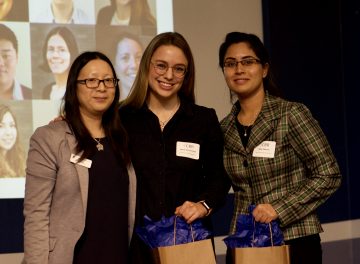
(L-R): Dr. Stefanie Mak with poster award recipients Marie-Soleil Smith and Neha Sharma.
The Earl Davie Symposium also placed an emphasis on posters, a sentiment echoed by the poster presenters. Three posters in particular were acknowledged with awards. These poster awards were presented to Chanel La (3rd place; Kizhakkedathu Laboratory, UBC), Marie-Soleil Smith (2nd place; Côté Laboratory, UBC), and Neha Sharma (1st place; Liaw Laboratory, McMaster University). Congratulations to all of the winners!
The success of the 2019 Earl Davie Symposium would not have been possible without the hard work of Dr. Ed Conway, Dr. Ed Pryzdial, Dr. Stefanie Mak, Mira Milutinovic, Andy Hsu, and the volunteers – thank you! Special thanks also go out to the sponsors of the symposium: the Naiman-Vickars Endowment Fund; Novo Nordisk; the Bayer-UBC Bleeding Disorders Collaboratory; Canadian Blood Services; Pfizer; CSL Behring; Alexion Pharmaceuticals; New England Biolabs; Grifols; Octapharma; and Stago.
To view photos and recordings of the event, click here.


